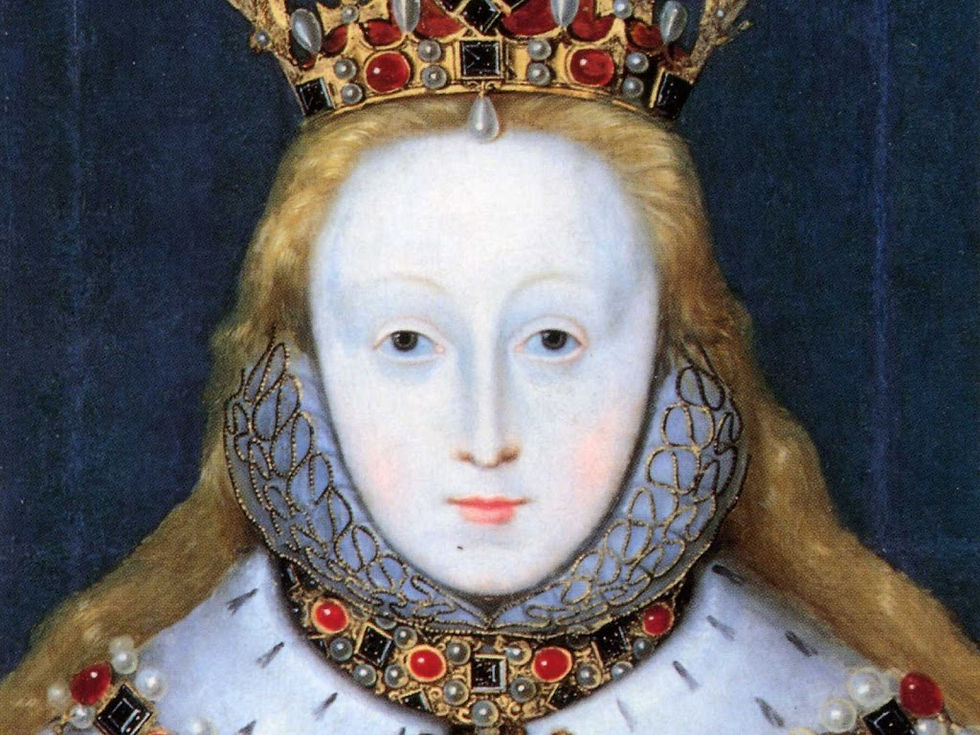Elizabethan Shaving Part 1: Eyebrows
- Mariela Rivero

- Jul 13, 2022
- 3 min read
Welcome to Part 1 of a 4-Part Series on Elizabethan Shaving!
What's next, you say? Here's the menu :)
Part 1: Elizabethan Eyebrows
Part 2: To Shave or Not to Shave & the Rise of the Barber-Surgeon
Part 3: Elizabethan Men’s Shaving Habits
Part 4: Shaving in Shakespeare's Canon: A Twist
Today, we’re covering Elizabethan eyebrows. Why? Because a discussion on beards takes a while, so we want to get this quick and easy one out of the way for ya! A little “calm before the storm”. A little "activity-filled". A little… little.
Eyebrow Shape - Women
Thin was in! Oh, and arched! (Or no brows at all!)
Such an eyebrow supported the trend of larger, more emphasized eyes.
It also helped create a tall forehead, to show off one’s nobility. (Women used to pluck their hairline how my mom parks in the parking lot... to the waaaay back.)
Below, is a picture of Queen Elizabeth I. Notice the eyebrows and hairline? Once you’re done admiring her trendiness, look at the other *cropped* pictures of famous people. These European paintings come from within 200 years of Queen Elizabeth's reign. Thus, the Elizabethan style was not just Elizabethan. (Remember: You're looking for thin, arched eyebrows and tall foreheads.)

Queen Elizabeth I - Ms. Fashion Mogul Herself

Saint Joan of Arc (Jean Pichore, 1506)

Joan of Arc (15th Century)

Nursing Madonna (Flemish, 16th Century)
Interestingly, though not surprisingly, Elizabethan artists tended to impose their eyebrow and other hair preferences onto the subjects featured in their work, even if those portrayed were from a time or place where Elizabethan hair fashion was... well, not fashionable. In other words, several painters took some "artistic liberty" when it came to historical accuracy.
Eyebrow Color - Women
Women dyed their eyebrows red in honor of Queen Elizabeth. Thus, no need to buy mascara! But you did have to get some urine to lock in the color, of course! Not sure whether the women were enthused about that…
(FOR MORE FUN FATCS ABOUT ELIZABETHAN HAIR COLOR - SYMBOLISM AND TENSIONS - AND HAIR ACCESSORIES, READ OUR PREVIOUS ARTICLE A Beginner's Guide: Elizabethan Ladies' Hair Fashion!)
Here’s a recipe for red dye, courtesy of Hugh Plat’s 1602 “Delightes for Ladies”! This was also used for men’s beards.
Eyebrows - Men
Observe the portraits below. Compare and contrast the eyebrows to come up with your own description of the ideal male Elizabethan eyebrows. Note differences in shape, color, social class…
You’ll find they're labeled underneath with a number rather than a name. Guess who the figure is, and check your answers below the last picture! To learn their stories, subscribe to our blog and you'll be notified when our article Secrets: The Private Lives of Elizabethan Nobles is published!

1

2

3

4
ANSWERS:
George Clifford, Earl of Cumberland
Lord Hunsdon
Charles Brandon, 1st Duke of Suffolk
Robert Dudley (soooo much tea on this guy)
Eyebrows Throughout History
We won’t spend much time on this, as we wish to focus on the 1500s/1600s. However, it’s important to remember how things came to be. Plus, it’s just barrels of fun to compare!
Ancient Egypt: Also wanted their eyes to stand out. Only they did it to pay homage to the god Horus. Ancient Egyptians elongated, arched, and darkened their brows.
Ancient Greece: Unibrows were a hit! Unmarried women might even apply black powder or paint on their brows to create a “sought-after” look.
Ancient Rome: Unibrows as well! No fuss, all nobility.
Victorian Era: Full, natural brows!
1920’s: Very thin and super straight.
1930’s: Back to high, rounded arches.
1960’s: Sophia Loren shaved off her brows and then penciled them in - short and thin.
DISCUSSION
For those interested in upgrading their own grooming habits, check out https://eshave.com.
That’s all for now! See, I told you: Substantially short :)
Prepare for next time. We’re gonna dig deep.
Written by Mariela Rivero
Edited by Laura Yumi Snell






How timely, a fabulous pair of eyebrows are high up on my list. This is an excellent subject blog, love it.